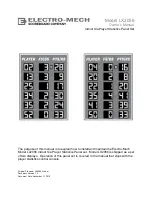
|
13
6.4 EARTHING
The earths for all site equipment should be integrated
(preferably deploying a single point earthing approach) and an
equipotential earth plane should be created. Integral to this is
the elimination of earth loops. It is common, but incorrect from
the point of lightning protection for there to be separate earths
for various services, ie electricity mains, telephone. computer
equipment and other building services.
For sites where the interconnection of these earths is
difficult, either for practical or regulatory reasons, the use
of a Potential Equalisation Clamp (PEC) is recommended.
The PEC behaves as an open circuit under normal operation,
but under surge conditions it activates to effectively clamp
individual points together.
The effectiveness of an SRF is intimately related to the
impedance presented by the earthing system to which it is
connected. A low impedance route to the earth is required (less
than 10 Ω
). This can be achieved by ensuring that the earth
electrode system at the site presents a low surge impedance
with respect to the ground. Additionally, the interconnecting
cabling must be of adequate cross sectional area and be routed
to provide as short and direct a path as is practical.
The earth conductor for the SRF should be sized according
to local regulations but with a minimum size of 6mm2, Every
attempt should be made to limit the cable length to under 5
metres. By selecting the most direct route, with the minimum
possible number of bends to the earth point or internal earth
bar, the risk of side flashing and excessive voltage rise across
the equipment is reduced. Figure 14 depicts the correct earthing
concept as described above.
ALL POWER AND
DATA CABLES
ENTER OR LEAVE
THE BUILDING
ON THE
SAME SIDE
(TO AVOID
EARTH LOOPS)
Figure 11. Preferred approach to equipotential bonding.
Installation and Operating Instructions






































